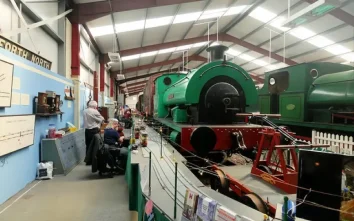Quarry Bank Mill
Quarry Bank Mill
- Entry:
- Admission fee
- Facilities: Cafe
- City/Town:
- Wilmslow
Museum Shop
Parking
Toilets
Accessibility
- Region:
- the North West
- Postcode:
- SK9 4LA
- Museum Category:
- Science, Industry & Technology
Official Website:
Quarry Bank Mill
Quarry Bank Mill: An Enduring Emblem of the Industrial Revolution
Nestled in the picturesque Cheshire countryside, Quarry Bank Mill stands as a powerful testament to the Industrial Revolution’s transformative energy. An iconic cotton mill from the 18th century, it encapsulates the epoch’s spirit of innovation, enterprise, and societal change. Today, as a part of the National Trust, it provides visitors with a tangible connection to Britain’s industrious past.
The Genesis of the Mill
Established in 1784 by Samuel Greg, Quarry Bank Mill was built at the cusp of a burgeoning cotton industry. Greg, recognizing the River Bollin’s potential for water power, set up the mill in its vicinity, paving the way for it to become one of the UK’s largest cotton-producing factories.
Architectural and Engineering Marvel
Quarry Bank Mill showcases an impressive blend of architectural and engineering prowess:
- Waterwheel: Initially powered by a large waterwheel, the mill demonstrates early industrial energy harnessing techniques.
- Steam Engines: As technology advanced, steam engines were integrated, highlighting the evolution of industrial machinery.
- Mill Buildings: The imposing red-brick structures, with their robust design, are indicative of the era’s architectural aesthetic.
A Window to Workers’ Lives
Beyond the machinery and production, Quarry Bank Mill also offers insights into the lives of those who fueled the Industrial Revolution:
- Apprentice House: A short walk from the main mill, this site was home to pauper children who were employed at Quarry Bank. Guided tours shed light on their daily routines, education, and overall life.
- Workers’ Village: Explore the homes of mill workers, illustrating the broader community that sprouted around such industrial hubs.
The Verdant Surroundings
Contrasting the mill’s industrial aura is the lush green landscape surrounding it:
- Gardens: Quarry Bank boasts expansive gardens, ranging from ornamental designs to kitchen gardens, echoing the Georgian love for horticulture.
- Woodland: Wander through the serene woodlands, which provide a tranquil backdrop to the mill’s bustling history.
Modern Interpretations
Over the years, Quarry Bank Mill has been rejuvenated with interactive exhibits:
- Textile Demonstrations: Witness live demonstrations of cotton processing, from spinning to weaving, showcasing the mill’s primary function.
- Exhibitions: Periodic exhibits delve into various facets of the mill’s history, from the Greg family’s legacy to the broader societal impact of cotton production.
Conservation and Heritage
In 1939, the mill came under the National Trust’s purview. Since then, extensive conservation efforts have ensured that both the buildings and the stories they hold continue to educate and inspire. Recognizing its significance, Quarry Bank Mill has also been designated as a Grade II* listed building.
Conclusion
Quarry Bank Mill is more than a relic of the past; it’s a living, breathing chronicle of an era that reshaped the world. As the clatter of looms echoes through its walls and the river’s gentle hum resonates, visitors are transported back in time, retracing the steps of those who stood at the forefront of industrial progress. Whether a history enthusiast, an architecture aficionado, or someone keen on understanding Britain’s rich tapestry, Quarry Bank Mill emerges as an indispensable destination.







